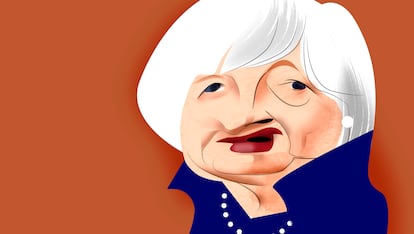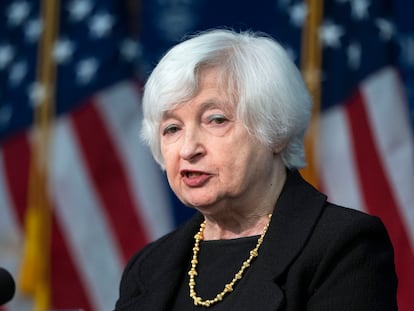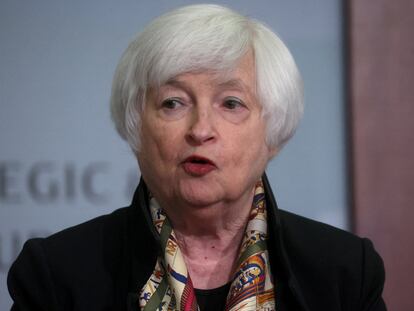Janet Yellen, the perfectionist economist who shatters all glass ceilings
The Treasury Secretary, a far-seeing and meticulous woman, faces the looming threat of the United States government defaulting on its debt

At the end of last year, United States Treasury Secretary Janet Yellen introduced a dollar bill for the ages: the first signed by two women. It was yet another milestone in a career in which she has often been the first to do whatever she sets out to. To break some many barriers, she has always been prepared. Before signing the dollar bill, for example, she knew that it was something she “could screw up” and she wanted to “get it right.” “And I practiced and practiced,” she admitted in a televised interview. A perfectionist, she is the type of person to arrive first at the airport before a trip. Thus, it is not difficult to imagine the anguish she must feel knowing that the U.S. could run out of money to pay its bills by June 1, if Congress does not remedy it.
Yellen was the first woman to head the White House economic team, under Bill Clinton; the first woman to chair the Federal Reserve, nominated by Barack Obama; the first woman to be Treasury Secretary, appointed by Joe Biden; and the first person, male or female, to hold all three positions. She has broken all the glass ceilings.
Janet Louise Yellen was born on August 13, 1946, in the quiet neighborhood of Bay Ridge, in Brooklyn, New York, into a wealthy Jewish family. Her father was a family physician with a home practice and her mother was an elementary school teacher. From her father she inherited compassion, and from her mother, many more traits, as Owen Ullmann writes in his biography Empathy Economics that Ruth Yellen taught her daughter to be super organized and always prepared, “to value public service, observe social norms, settle for nothing less than perfection.” Yellen herself recounts in the book, “She did not tolerate deviations from perfection terribly well.” And that she was obliged to get straight A’s or honors in school. When in her first year at university she got a B in German — the only one of her life — it was little short of a trauma.
Yellen did three years worth of high school in just two years. She graduated with honors in 1967 from Brown University, where she began studying philosophy and then switched to economics, and received her Ph.D. in 1971 from Yale, as the only woman in a program of more than a score of students — both of which are elite Ivy League universities.
She was an assistant professor at Harvard until 1976, when she began working at the Federal Reserve. There, in the cafeteria, she met fellow economist George Akerlof in 1977. “Janet and George fell in love at the Fed. She was drawn to his inventive mind; he was drawn to her calm and grounded nature and the devotion she brought to her work,” says Jon Hilsenrath, author of Yellen, a side-by-side biography of the Treasury secretary and her husband, a 2001 Nobel laureate in economics. “Life was odd, and they were a little odd, too, and they found the oddities amusing. They decided just a few weeks after meeting to marry, setting out on a journey through an era of upheaval together. When they traveled, they took along suitcases full of books. Janet also packed her own pillow, because hotel pillows were often too fluffy and hurt her neck,” he writes.
In 1980, she began teaching at the University of California at Berkeley. Her academic work focused on the labor market and macroeconomics. In 1994, President Bill Clinton appointed her as a Federal Reserve advisor and, three years later, as chair of the White House Council of Economic Advisors. In 2004, she was appointed president of the Federal Reserve Bank of San Francisco. From the central bank, she lived through the crash of the real estate market and the financial crisis of 2008. In 2010, Barack Obama appointed her as Vice Chair of the Federal Reserve and four years later she replaced Ben Bernanke as Chair.
When Donald Trump arrived at the White House she decided not to renew her term. In 2018, at 71, Yellen thought her public life was over and went back to enjoying the simple pleasures of life, such as going to bed early, Hilsenrath’s biography recounts. But when Joe Biden was elected president, he asked Yellen to take over the Treasury Department to revive an economy battered by the pandemic. At first, she said no, but then changed her mind. She felt she had a duty to take the job.
In her current role, Yellen made perhaps the biggest mistake of her career. She thought inflation was transitory. She was wrong, although it was a fairly widespread mistake. But during her tenure she has also enjoyed a vigorous recovery and a very strong job market. There has been speculation that she might leave office once the nation’s economic recovery is back on track, but with the banking storm that erupted in March, the debt limit dilemma and her sense of duty, it does not seem likely that she would leave the Biden Administration.
Hilsenrath defines Yellen as a methodical person: “Do your homework, Yellen learned. Don’t be caught off guard by outcomes you could have foreseen. Eliminate worries. Reduce necessary risks. Prepare.” Now, the Treasury Secretary is forced to rely on a divided Congress. She needs the legislative body to approve raising the debt limit, so the government is not forced to default on its debt. Defaulting, she has warned, would have catastrophic consequences for the economy. Playing with fire is against her nature. Surely, she is thinking of a plan B.
Sign up for our weekly newsletter to get more English-language news coverage from EL PAÍS USA Edition
Tu suscripción se está usando en otro dispositivo
¿Quieres añadir otro usuario a tu suscripción?
Si continúas leyendo en este dispositivo, no se podrá leer en el otro.
FlechaTu suscripción se está usando en otro dispositivo y solo puedes acceder a EL PAÍS desde un dispositivo a la vez.
Si quieres compartir tu cuenta, cambia tu suscripción a la modalidad Premium, así podrás añadir otro usuario. Cada uno accederá con su propia cuenta de email, lo que os permitirá personalizar vuestra experiencia en EL PAÍS.
¿Tienes una suscripción de empresa? Accede aquí para contratar más cuentas.
En el caso de no saber quién está usando tu cuenta, te recomendamos cambiar tu contraseña aquí.
Si decides continuar compartiendo tu cuenta, este mensaje se mostrará en tu dispositivo y en el de la otra persona que está usando tu cuenta de forma indefinida, afectando a tu experiencia de lectura. Puedes consultar aquí los términos y condiciones de la suscripción digital.
More information
Archived In
Últimas noticias
Most viewed
- Sinaloa Cartel war is taking its toll on Los Chapitos
- Oona Chaplin: ‘I told James Cameron that I was living in a treehouse and starting a permaculture project with a friend’
- Reinhard Genzel, Nobel laureate in physics: ‘One-minute videos will never give you the truth’
- Why the price of coffee has skyrocketed: from Brazilian plantations to specialty coffee houses
- Silver prices are going crazy: This is what’s fueling the rally











































